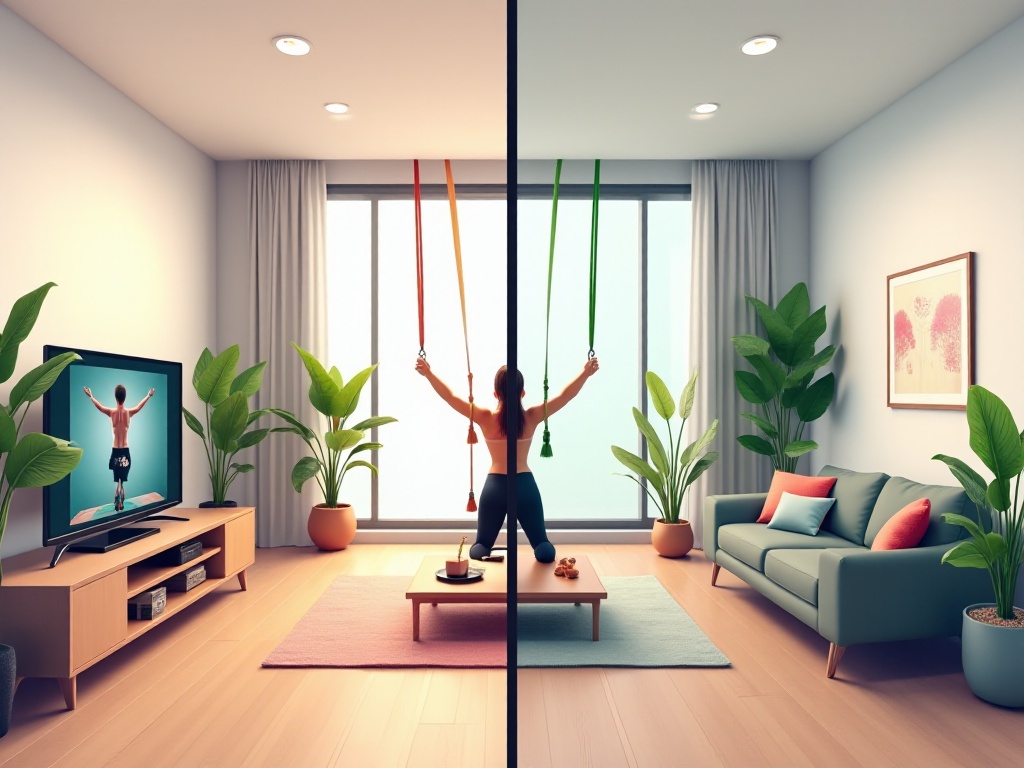Introduction
Every time I see fitness check-ins on social media, I feel inspired, but the thought of going to the gym instantly kills my motivation. Even when I get a gym membership, there's always an excuse - overtime work, dates, gatherings - to skip it. As a fitness beginner frequently troubled by these issues, I decided to start my home fitness journey. After six months of exploration and practice, I've compiled a set of super practical home workout tips to share with those facing similar struggles.
Choosing the Right Space
Many people think their homes are too small for exercise. I thought the same until I discovered that any corner could become a personal gym.
I live in a 400-square-foot apartment, but I managed to create a 20-square-foot workout zone in front of the living room TV. This area features my favorite pink yoga mat and simple exercise equipment. Every day after work, seeing this corner gives me a sense of anticipation. I intentionally set up this space next to the floor-to-ceiling windows, so I can enjoy sunlight during morning workouts and city views during evening sessions.
Ventilation is also crucial. I open the windows before exercising to fill the room with fresh air. On nice days, I move my yoga mat to the balcony to exercise while breathing fresh air, feeling completely refreshed. Remember to put an anti-slip mat on the floor for safety and to avoid disturbing downstairs neighbors.

Getting Equipment
When it comes to fitness equipment, many people's first thought is "too expensive." However, everyday items can be the best fitness equipment - it's all about using what you have creatively.
Here's my "budget fitness equipment list": two 1.5L water bottles serve as dumbbells, perfectly weighted when filled; a regular bath towel becomes a yoga strap; a dining chair assists with squats and push-ups; sofa cushions help with core training; and the stairwell is perfect for cardio.
Besides these substitutes, I also bought some high-value small equipment. A jump rope costs just a few dollars but is portable and great for burning fat; a resistance band for twenty or thirty dollars enables hundreds of exercises; an exercise ball, though space-consuming, is excellent for core training and stretching.
Recently, I discovered a super useful tool - a foam roller. Although it hurts at first, it's particularly effective for relieving post-workout muscle soreness. All this equipment together didn't cost much but saved me a lot in gym fees.

Time Management
Time management is definitely the biggest challenge in home fitness. As someone who often works overtime, I totally understand this struggle. But through this period of exploration, I've discovered some time management techniques.
First is fixing workout times. I set 7:00-7:30 AM as my non-negotiable exercise time, which meant moving my wake-up time to 6:30 AM. It was extremely difficult at first, but I got used to it after a month. Now, the first thing I do every morning is change into workout clothes, giving myself no chance to be lazy.
If you can't find a continuous half hour, then squeeze in exercise where you can. During lunch breaks, I find a quiet corner for 10 minutes of stretching; during TV commercials, I jump rope; even on weekend sleep-ins, I can do simple core exercises in bed.
I've found that breaking up exercise time actually makes it easier to maintain. Like 10 minutes of full-body stretching in the morning, 10 minutes of strength training at noon, and 10 minutes of cardio in the evening. This not only prevents exhaustion but keeps you energized throughout the day.

Gradual Progress
The biggest mistake in fitness is trying to achieve everything at once. I learned this the hard way. When I first started home workouts, I watched some fitness influencers' videos and created a brutal training plan: two hours of training daily, demanding myself not to skip a single day in a week. The result was predictable - I burned out after just three days and lost all interest in exercise.
Later, I changed my strategy and started with basic movements. The first week's goal was simple: just 15 minutes of basic stretching daily. This goal seemed easy, but it was quite challenging for a beginner. Only after this habit truly formed did I gradually increase the intensity and duration.
Looking back, that gradual progress, though seemingly slow, built the most solid foundation. By slowly increasing training volume, my body had enough time to adapt, and I avoided any exercise injuries. From the initial 15 minutes of basic stretching to now easily completing an hour of comprehensive training, this process taught me that "haste makes waste."
Maintaining Motivation
Honestly, the first two weeks of exercise are the toughest. Fighting laziness every day while enduring post-workout soreness. If I hadn't set some interesting small goals and reward mechanisms, I probably would have given up early.
My motivation system is simple: I made a check-in chart and draw a little star for each completed workout. A week of consecutive check-ins earns me a new sports bra; a month earns a pair of long-desired workout shoes; three months earns me an escape room experience I've wanted to try.
Besides material rewards, I regularly take photos and measure body data. Seeing the changes in photos and feeling physical improvements provides a sense of achievement better than any reward. Now I can clearly feel my improved fitness: no more panting on stairs, carrying heavy shopping bags longer distances, and even better sleep quality.

Lifestyle Integration
Recently, I discovered an interesting phenomenon: when exercise truly becomes part of life, it doesn't feel like a hassle anymore. The key is learning to integrate exercise into various aspects of daily life.
For example, I've developed a habit of practicing single-leg stands while brushing teeth, which trains balance and core muscles. I do simple stretches ten minutes before showering, which not only relaxes body and mind but makes bathing more comfortable. While watching TV, I unconsciously tighten my abs and occasionally do seated core exercises.
When going out, I deliberately choose walking or shared bikes instead of buses or taxis. At the office, I exercise with colleagues during lunch breaks. Even while watching dramas, I do some light stretching exercises.
These small habits might seem insignificant, but they add up over time with noticeable results. Most importantly, this way of integrating exercise into life feels natural, without any sense of being forced.

Conclusion
Looking back on this six-month home fitness journey, my biggest realization is: exercise isn't that complicated; the key is finding what works for you. Don't be intimidated by those impressive fitness experts, and don't think you must go to the gym for real exercise. Actually, just doing a little bit every day is much better than lying on the couch scrolling through your phone.
Along this journey, I've experienced times of low motivation and training interruptions due to work. But every time I return to that 20-square-foot workout space, I rediscover my initial motivation for starting exercise. Now I not only have a better figure, but I'm also more energetic and more efficient at work.
So, if you're hesitating about starting exercise, why not begin today, starting with the simplest movements. Remember, exercise isn't about form, but persistence. As long as you take action every day, you'll definitely achieve unexpected surprises.
Looking forward to seeing your home fitness stories in the comments!


